Even when I first started getting tattooed in the early 2000s, it felt like a rebellious act. The idea of women embracing tattoos as a form of personal expression and empowerment is deeply rooted in history. As Margot Mifflin notes in Bodies of Subversion: a secret history of women and tattoos, “Tattoos appeal to contemporary women both as emblems of empowerment in an era of feminist gains and as badges of self-determination at a time when controversies about abortion rights, date rape, and sexual harassment have made them think hard about who controls their bodies – and why.”
However, the narrative of women and tattoos extends far beyond the modern era. In 1879, a New York tabloid, The National Police Gazette, published an article titled ‘The Tattoo Trick,’ revealing a female tattooist in a respectable neighborhood who reported thriving business, primarily with women clients. These glimpses into the past ignite our curiosity about the tattooed women who came before us. What were their stories? What inspired their love for ink? And what societal barriers did they overcome?
To understand the legacy of these pioneering women, let’s delve into the stories of some remarkable figures. These are the tattooed women of history who paved the way for today’s thriving community of female tattoo artists and enthusiasts. Many of these women began their journeys in the early 20th century, a time when women faced significant limitations in their personal and political lives. Imagine the audacity and liberation they found in claiming their bodies as canvases and inking not only themselves but also other women. This is truly tattoo herstory.
Maud Wagner
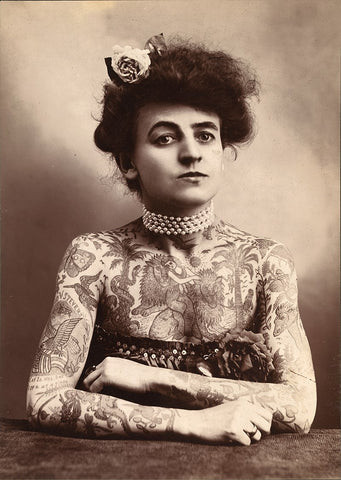 Maud Wagner, one of the first known female tattoo artists, showcasing her full-body traditional tattoos.
Maud Wagner, one of the first known female tattoo artists, showcasing her full-body traditional tattoos.
Maud Wagner’s path to tattooing began in the circus, where she worked as an aerialist and contortionist. In 1904, her life took a turn when she met tattoo artist Gus Wagner. Their courtship was unconventional: Maud agreed to a date only if Gus would teach her the art of tattooing. As fate would have it, she married Gus and became Maud Wagner. By 1907, Maud was practicing tattooing using the traditional stick and poke method. She not only mastered the craft but also became a canvas herself, adorned with extensive tattoos. Maud Wagner stands as a significant figure in tattoo history, representing early women’s participation in tattoo artistry and body modification.
Jessie Knight
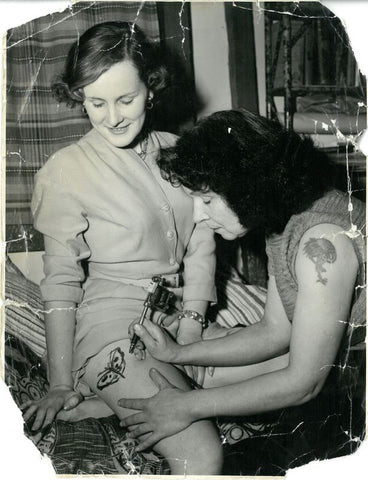 Jessie Knight, considered Britain's first female tattoo artist, pictured in her shop with immaculately styled hair and a formal suit.
Jessie Knight, considered Britain's first female tattoo artist, pictured in her shop with immaculately styled hair and a formal suit.
Jessie Knight holds the distinction of being widely recognized as the UK’s first professional female tattoo artist. She began her tattooing career at the young age of 17 in 1921, learning the trade from her father, a sailor and tattooist. When her father was away at sea, Jessie took charge of his tattoo shop in Barry, South Wales. Aware of the social stigma surrounding female tattoo artists, Jessie consciously adopted a professional image. She always wore a suit to work and maintained an immaculate hairstyle, aiming to project respectability in a male-dominated and often prejudiced environment. Despite her efforts, prejudice persisted. “They call me a vampire and a nasty cat,” she wrote in a poem in her diary during the 1940s, revealing the harsh realities of her pioneering role. Jessie Knight’s career spanned decades, tattooing well into the 1980s and running multiple shops, solidifying her legacy in British tattoo history.
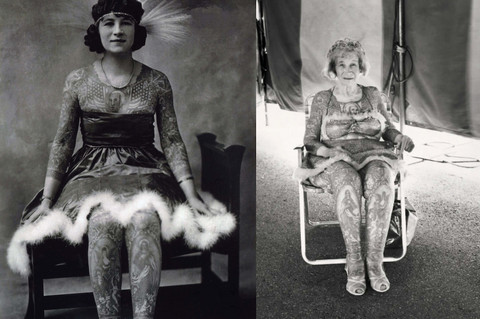 Artoria Gibbons, a tattooed lady performer, displaying her full-body religious art tattoos in vibrant color.
Artoria Gibbons, a tattooed lady performer, displaying her full-body religious art tattoos in vibrant color.
Artoria Gibbons
Artoria Gibbons carved her niche as a celebrated “tattooed lady” performer. To captivate audiences, a sensationalized backstory was often fabricated: it was said she had married a possessive older man who tattooed her entire body to deter other admirers. The reality was more collaborative. Artoria’s husband, Charles “Red” Gibbons, was a renowned tattoo artist. Together, they conceived the idea of Artoria becoming a performing tattooed lady as a means of earning a living. Charles tattooed Artoria in full color, covering her body with images inspired by her favorite religious art. These designs included masterpieces like Botticelli’s The Annunciation and Michelangelo’s Doni Tondo, transforming her body into a walking canvas of art history. Artoria performed for decades, starting in the 1920s and continuing until her retirement in 1981, enchanting audiences with her living art and challenging societal norms about women’s bodies and public display.
Mildred Hull
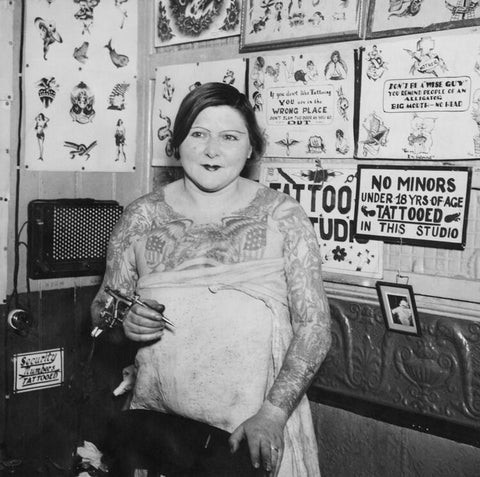 Mildred Hull, known as Millie, a pioneering female tattoo artist in New York City, photographed in her studio.
Mildred Hull, known as Millie, a pioneering female tattoo artist in New York City, photographed in her studio.
Mildred Hull, affectionately known as Millie, born in 1897, was a true trailblazer. A former burlesque dancer, Millie distinguished herself as one of the first women to independently learn the art of tattooing, without relying on a male partner or mentor. She catered to a diverse clientele, tattooing many women who often requested sentimental designs like hearts with lovers’ names and “mother” tattoos. In 1943, she was recognized as New York City’s only female tattooist, a remarkable feat considering tattooing was illegal in NYC until 1997. In a Foto Magazine interview, Millie offered an insightful perspective on her clientele: “I think men rather like having a woman tattoo them. They think a woman is likely to be more careful.” Sadly, Mildred Hull’s life ended tragically in 1947.
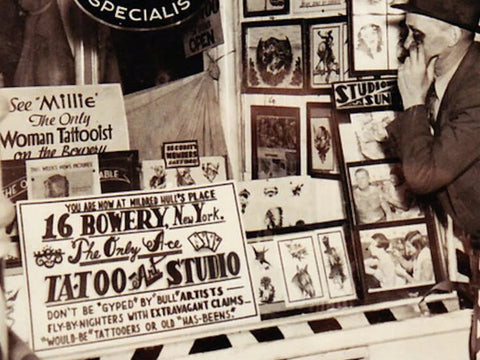 A vintage tattoo flash sheet attributed to Millie Hull, showcasing classic tattoo designs popular among women in her era.
A vintage tattoo flash sheet attributed to Millie Hull, showcasing classic tattoo designs popular among women in her era.
Valie Export
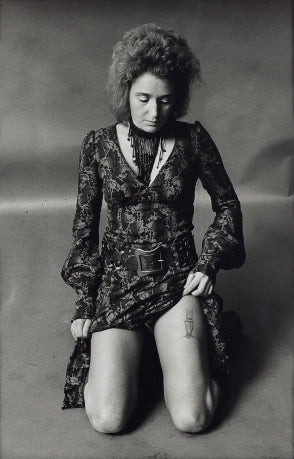 Valie Export, performance artist, publicly receiving her suspender belt tattoo in Frankfurt, Germany.
Valie Export, performance artist, publicly receiving her suspender belt tattoo in Frankfurt, Germany.
Valie Export, an Austrian performance artist, used her body as a canvas for social commentary. In July 1970, in Frankfurt, Germany, she undertook a public tattooing performance. Valie had a suspender belt tattooed onto her thigh. This act was a powerful statement intended to critique the sexual objectification of women. “Tattooing the body demonstrates the connection between ritual and civilization,” she wrote, reflecting on her performance. “In the tattoo the garter appears as a sign of a past enslavement, clothing as the suppression of sexuality, the garter as an attribute of a femininity not determined by ourselves.” Valie Export’s tattoo became a lasting symbol of feminist art, using body modification to challenge societal perceptions of women and sexuality.
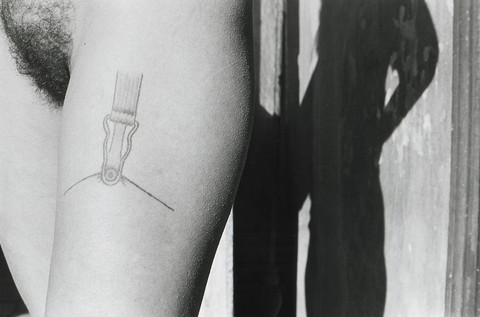 Close-up of Valie Export's suspender belt tattoo, a symbolic representation of female objectification and liberation.
Close-up of Valie Export's suspender belt tattoo, a symbolic representation of female objectification and liberation.
Jacci Gresham
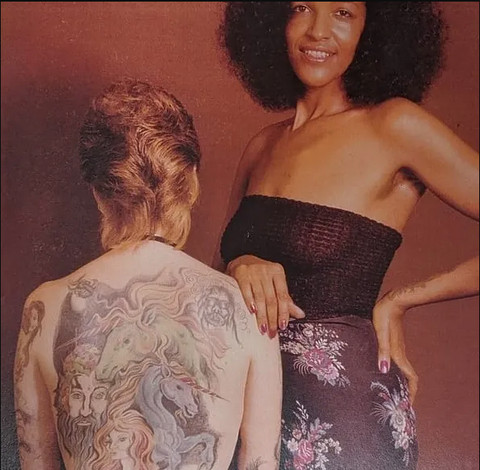 Jacci Gresham, the first African American female tattoo artist in the USA, working in her New Orleans studio.
Jacci Gresham, the first African American female tattoo artist in the USA, working in her New Orleans studio.
Jacci Gresham is a living legend and a true icon, recognized as the USA’s first Black female tattoo artist. She learned to operate a tattoo machine in 1972, breaking barriers in not just a male-dominated industry, but also one that was overwhelmingly white. Her shop, Aart Accent Tattoos, located in New Orleans, holds historical significance as the first tattoo studio opened by a Black woman in the United States. Jacci, now in her 70s, continues to tattoo to this day, inspiring generations of artists and clients alike. Her shop’s bold slogan, “Look better naked – get a tattoo,” encapsulates her confident spirit and the empowering nature of tattoos.
A post shared by Jacci Gresham (@aartaccenttat2)
Isobel Varley
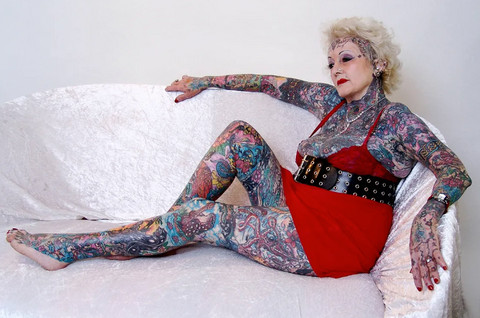 Isobel Varley, the world's most tattooed female pensioner, showcasing her extensive body suit tattoos.
Isobel Varley, the world's most tattooed female pensioner, showcasing her extensive body suit tattoos.
Isobel Varley embraced tattoos later in life, becoming famously known as the world’s most tattooed female pensioner. “Originally, I was only ever going to have one – a small bird – but I fell in love with it, and developed an addiction,” Isobel explained upon receiving her Guinness World Record title for being the most tattooed senior citizen. A former secretary, Isobel had an astounding 93% of her body covered in tattoos. She got her first tattoo at the age of 49 at the Hammersmith Palais in 1986. This initial experience ignited a passion that led to her collecting over 200 tattoos in a decade. Among her extensive collection, her favorite design was a family of tigers on her stomach. Isobel Varley passed away in 2015 at the age of 77, leaving behind a legacy of embracing body modification at any age.
These women, through their art and lives, challenged conventions, defied expectations, and indelibly marked the history of tattoos. Their stories remind us that women’s tattoos are not just a modern trend, but a powerful form of self-expression with deep historical roots, paved by courageous pioneers.